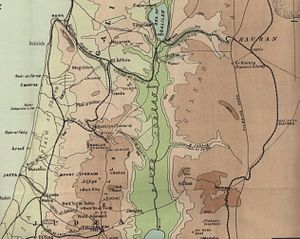Battle of Megiddo (1918)
| Battle of Megiddo | |||||||
|---|---|---|---|---|---|---|---|
| Part of the Middle Eastern theatre of World War I | |||||||
 Map of the Megiddo battlefield |
|||||||
|
|||||||
| Belligerents | |||||||
|
|
|
||||||
| Commanders and leaders | |||||||
|
(Egyptian Expeditionary Force) (XX Corps) (XXI Corps) (Sharifian Army) |
(Yıldırım Army Group) (Eighth Army) (Seventh Army) (Fourth Army) |
||||||
| Strength | |||||||
|
Allied 12,000 mounted troops, 57,000 infantry, 540 guns Arab 4,000+ regulars unknown no. irregulars |
3,000 mounted troops, 32,000 infantry, 402 guns |
||||||
| Casualties and losses | |||||||
| 782 killed, 382 missing, 4,179 wounded |
Destruction or surrender of Ottoman forces – only 6,000 escaped capture |
||||||
The Battle of Megiddo (Turkish: Megiddo Muharebesi) also known in Turkish as the Nablus Hezimeti ("Rout of Nablus"), the Nablus Yarması ("Breakthrough at Nablus") was fought between 19 and 25 September 1918, on the Plain of Sharon, in front of Tulkarm, Tabsor and Arara in the Judean Hills as well as on the Esdralon Plain at Nazareth, Afulah, Beisan, Jenin and Samakh.
The Battle of Megiddo was the final Allied offensive of the Sinai and Palestine Campaign of the First World War. The contending forces were the Allied Egyptian Expeditionary Force, of three corps including one of mounted troops, and the Ottoman Yildirim Army Group which numbered three armies, each the strength of barely an Allied corps. The series of battles took place in what was then the central and northern parts of Ottoman Palestine and parts of present-day Israel, Syria and Jordan. After forces of the Arab Revolt attacked the Ottoman lines of communication, distracting the Ottomans, British and Indian infantry divisions attacked and broke through the Ottoman defensive lines in the sector adjacent to the coast in the set-piece Battle of Sharon. The Desert Mounted Corps rode through the breach and almost encircled the Ottoman Eighth and Seventh Armies still fighting in the Judean Hills. The subsidiary Battle of Nablus was fought virtually simultaneously in the Judean Hills in front of Nablus and at crossings of the Jordan River. The Ottoman Fourth Army was subsequently attacked in the Hills of Moab at Es Salt and Amman.
...
Wikipedia
